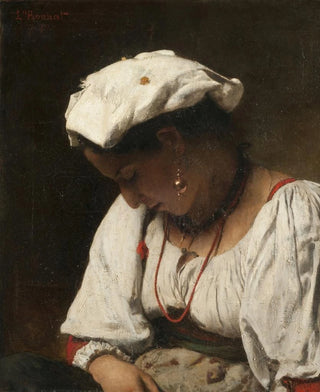Art print | The Victim - Léon Bonnat


View from behind

Frame (optional)
In the rich and diverse panorama of art history, certain works stand out for their ability to capture the human essence in all its complexity. "The Victim" by Léon Bonnat is a striking example. This canvas, imbued with palpable emotion, evokes suffering but also the dignity of the human being in the face of adversity. By immersing oneself in this artwork, the viewer is invited to feel the nuances of pain and resilience, as if each brushstroke told a forgotten story. The scene, both tragic and beautiful, challenges us and prompts reflection on the human condition, making this piece a true masterpiece.
Style and uniqueness of the work
Léon Bonnat's style is characterized by undeniable technical mastery and meticulous attention to detail. In "The Victim," the artist deploys a palette of dark colors, emphasizing the drama of the depicted scene. The interplay of shadow and light creates an atmosphere that is both heavy and emotional, highlighting the features of the central figure's face. This figure, in its posture, expresses a suffering that transcends time and space, touching the viewer's heart directly. The composition of the work, although traditional in approach, reveals a modernity in the treatment of emotions, allowing Bonnat to stand out from other artists of his era. Thus, "The Victim" becomes an open window into the torments of the human soul, where each gaze upon the canvas reveals a new interpretation.
The artist and his influence
Léon Bonnat, born in 1833, is often regarded as one of the masters of realism and neoclassicism. His training with the great names of the time, such as Jean-Auguste-Dominique Ingres, profoundly influenced his artistic approach. Bonnat always sought to represent human truth, not only through portraits but also through historical and mythological scenes. His work "The Victim" embodies this quest for truth, where every detail is carefully thought out to evoke raw emotion. Bonnat's impact on his contemporaries and future generations is undeniable.

Matte finish

View from behind

Frame (optional)
In the rich and diverse panorama of art history, certain works stand out for their ability to capture the human essence in all its complexity. "The Victim" by Léon Bonnat is a striking example. This canvas, imbued with palpable emotion, evokes suffering but also the dignity of the human being in the face of adversity. By immersing oneself in this artwork, the viewer is invited to feel the nuances of pain and resilience, as if each brushstroke told a forgotten story. The scene, both tragic and beautiful, challenges us and prompts reflection on the human condition, making this piece a true masterpiece.
Style and uniqueness of the work
Léon Bonnat's style is characterized by undeniable technical mastery and meticulous attention to detail. In "The Victim," the artist deploys a palette of dark colors, emphasizing the drama of the depicted scene. The interplay of shadow and light creates an atmosphere that is both heavy and emotional, highlighting the features of the central figure's face. This figure, in its posture, expresses a suffering that transcends time and space, touching the viewer's heart directly. The composition of the work, although traditional in approach, reveals a modernity in the treatment of emotions, allowing Bonnat to stand out from other artists of his era. Thus, "The Victim" becomes an open window into the torments of the human soul, where each gaze upon the canvas reveals a new interpretation.
The artist and his influence
Léon Bonnat, born in 1833, is often regarded as one of the masters of realism and neoclassicism. His training with the great names of the time, such as Jean-Auguste-Dominique Ingres, profoundly influenced his artistic approach. Bonnat always sought to represent human truth, not only through portraits but also through historical and mythological scenes. His work "The Victim" embodies this quest for truth, where every detail is carefully thought out to evoke raw emotion. Bonnat's impact on his contemporaries and future generations is undeniable.






